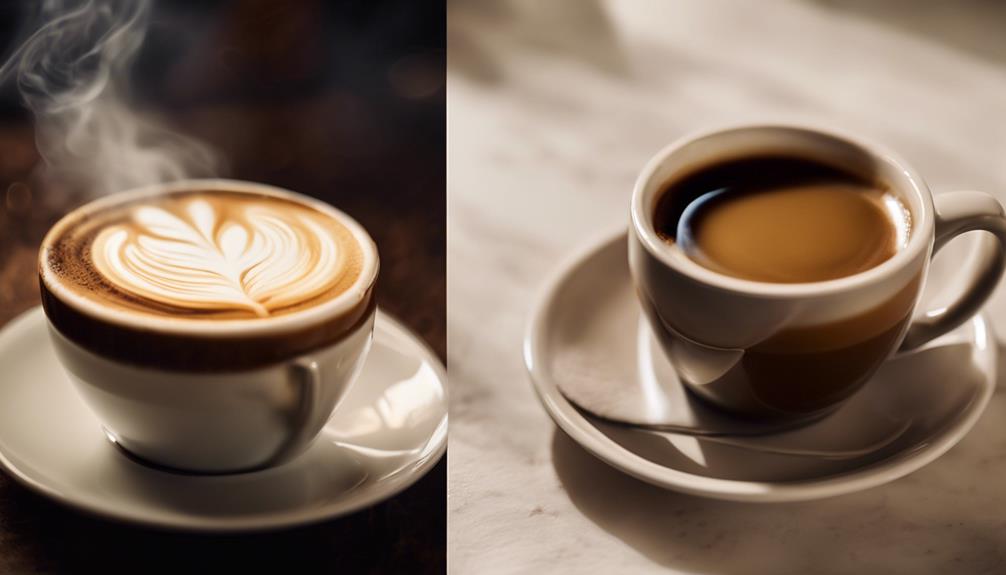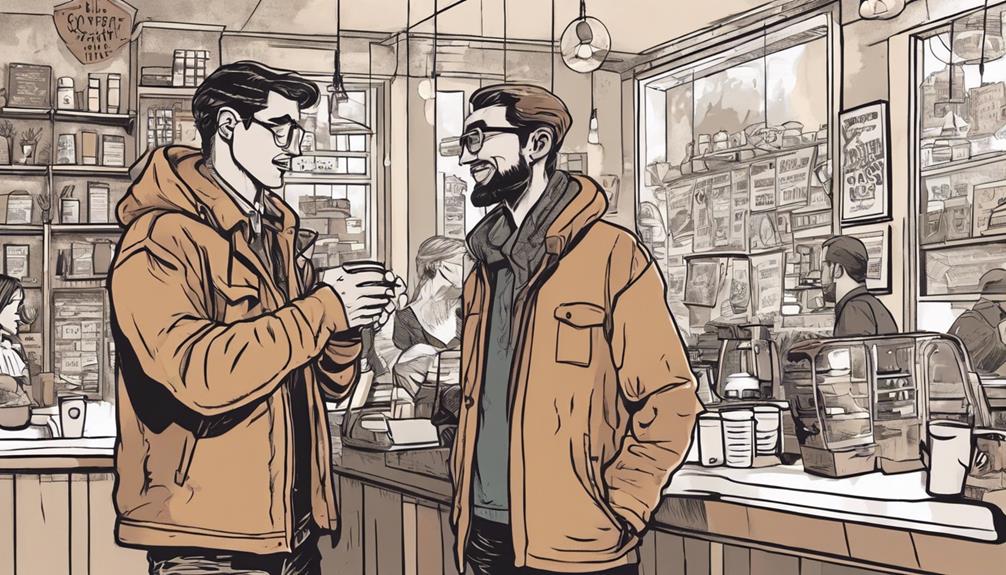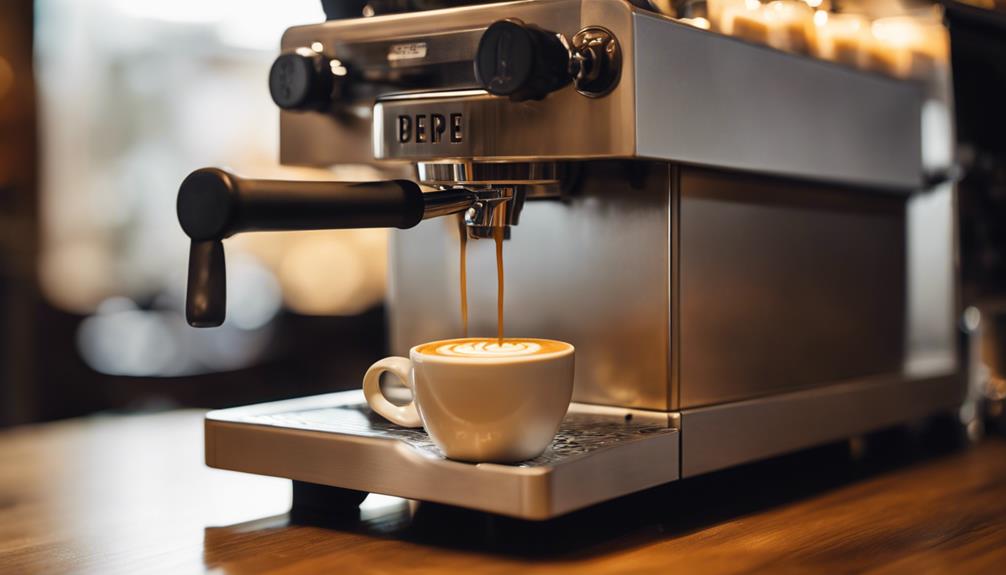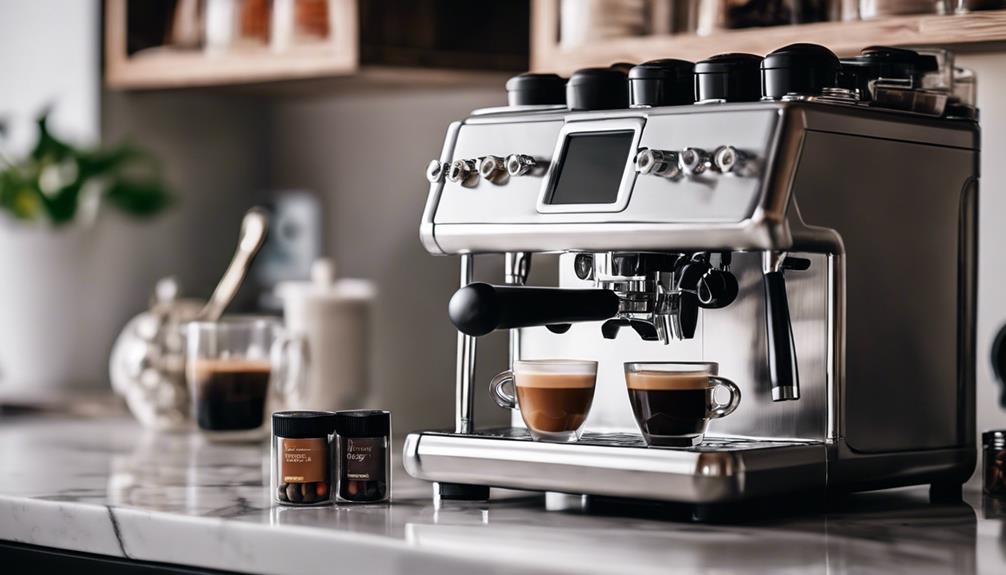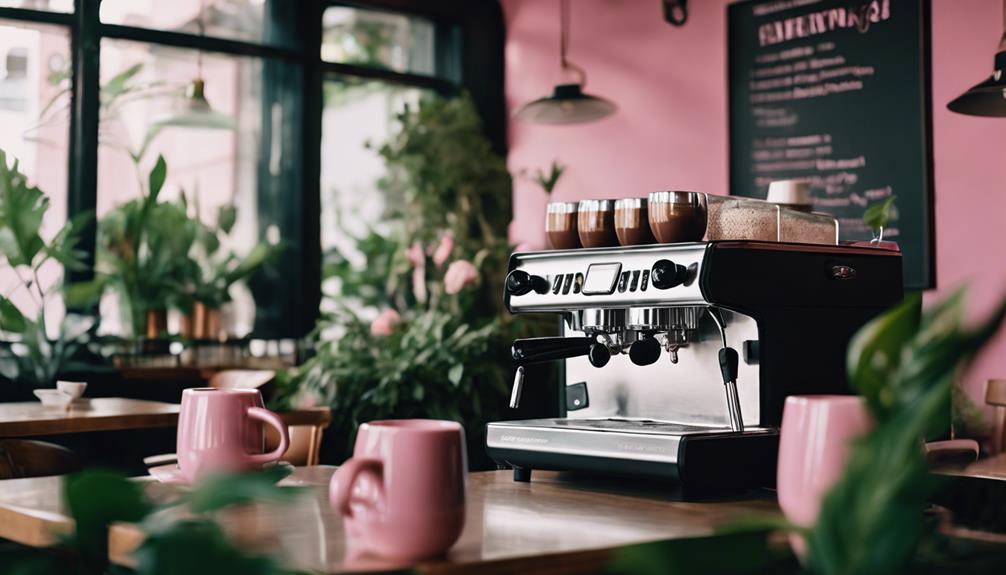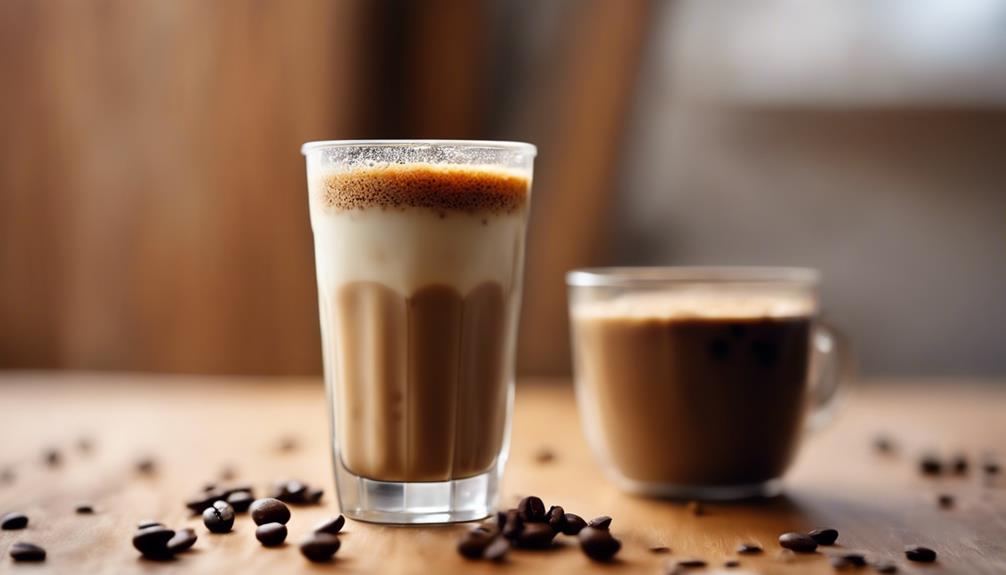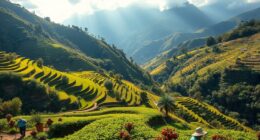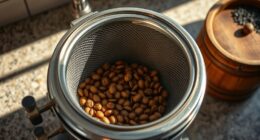You are about to learn what makes coffee and espresso unique. The brewing basics are key: coffee has a 1:18 coffee-to-water ratio, while espresso is a more concentrated 1:2. The methods also differ, with espresso requiring high pressure and precise temperature control, while coffee involves an immersion process. Even the grind size varies, with espresso needing a fine grind and coffee using a medium-coarse one. As you delve into the variations in pressure, extraction, and texture, you will discover there is much more to explore, and your newfound knowledge is just the start of a flavorful and fulfilling journey.
Key Takeaways
- Espresso uses a 1:2 coffee-to-water ratio, whereas coffee uses a 1:18 ratio, resulting in a more concentrated flavor.
- Espresso machines require high pressure (9 bars) and precise temperature control, unlike coffee brewing which relies on gravity.
- Espresso has a rich, velvety mouthfeel and a thick crema, absent in brewed coffee due to its fine grind and high pressure.
- A 1 oz shot of espresso contains approximately 63 mg of caffeine, while an 8 oz cup of brewed coffee contains around 95 mg.
Coffee Vs Espresso Basics
When you explore the world of coffee and espresso, one of the first things you'll notice is that these two beloved beverages have distinct differences in their preparation, composition, and overall character. Espresso, for example, is prepared using a small amount of boiling water that is forced through finely-ground coffee beans at a high pressure. This results in a strong and concentrated shot of coffee, with a rich and velvety crema on top. On the other hand, traditional coffee is made by steeping coarsely-ground coffee beans in hot water, resulting in a milder and more diluted flavor. When comparing espresso versus coffee, it’s important to consider your preference for either a quick and intense pick-me-up or a more leisurely and mellow drinking experience.
Coffee and espresso are brewed using different ratios of grounds to water. For coffee, it's around 1:18, while espresso uses a much more concentrated ratio of 1:2. This difference in brewing ratio affects the flavor and texture of the final product.
Espresso's high-pressure brewing process (around 9 bars) results in a thicker consistency and a rich layer of crema, whereas coffee is brewed using gravity through methods like drip or pour-over.
Even the grind size varies, with espresso requiring a very fine grind and coffee needing a medium-coarse grind for best extraction.
These fundamental differences set the stage for the unique characteristics of each beverage, from flavor to serving size.
Brewing Methods Compared
As you explore the world of coffee and espresso, you'll notice significant differences in their brewing methods.
You'll find that the equipment, brewing time, and pressure all play a vital role in extracting the perfect flavor.
Now, let's take a closer look at the essentials of espresso machines, compare brewing times, and examine how pressure affects extraction.
Espresso Machine Essentials
You'll need a machine that can deliver high pressure and precise temperature control to brew a perfect espresso shot, which is where espresso machine essentials come into play.
When brewing espresso, you're working with finely-ground coffee grounds that require a specialized setup to extract the perfect shot. Espresso machines utilize high pressure (around 9 bars or 130 lbs) to force hot water through the grounds, resulting in a concentrated shot within 20-30 seconds.
In contrast, coffee brewing methods like drip or pour-over rely on gravity and take much longer. To achieve the ideal extraction process, espresso machines must maintain a precise temperature between 190-205°F.
The water-to-coffee ratio is also essential, with espresso requiring a 1:2 ratio compared to coffee's 1:18 ratio.
With the right machine and settings, you'll be able to reveal the rich, thick flavor that espresso is known for. By understanding these espresso machine essentials, you'll be well on your way to brewing like a pro.
Brewing Time Compared
Now that you've got the right machine and settings, let's explore how brewing time affects the flavor of your coffee and espresso.
When it comes to brewing methods, coffee typically takes between 4 to 12 minutes to brew, depending on the technique used. On the other hand, espresso brewing is markedly quicker, requiring only 20 to 30 seconds to brew a concentrated shot under high pressure.
This difference in brewing time greatly impacts the flavor profile of your coffee and espresso. The longer brewing time for coffee allows for a more gradual extraction of flavors, resulting in a smoother taste. In contrast, the rapid process of espresso brewing results in a bold and intense flavor profile.
The brewing time also affects the immersion process, with coffee involving immersion and espresso requiring pressurized water to pass through finely ground coffee.
Pressure and Extraction
Compare the brewing methods of coffee and espresso, and you'll immediately notice the notable difference in pressure and extraction techniques used to produce these two popular beverages. When it comes to pressure, espresso brewing involves forcing hot water through finely-ground coffee under high pressure (around 9 bars or 130 lbs), whereas coffee brewing typically relies on gravity, with no added pressure.
Here's a breakdown of the key differences in pressure and extraction:
| Pressure | Extraction Time | Grounds to Water Ratio | |
|---|---|---|---|
| Espresso | High (9 bars) | 20-30 seconds | 1:2 |
| Drip Coffee | Low (gravity) | 4-12 minutes | 1:18 |
| French Press | Low (gravity) | 4-5 minutes | 1:15 |
| Pour-over | Low (gravity) | 3-4 minutes | 1:15 |
The extraction time for espresso is notably shorter, and the grounds to water ratio is much lower, resulting in a more intense flavor. In contrast, coffee brewing times vary depending on the method, and the grounds to water ratio is higher, leading to a less concentrated beverage. These differences in pressure and extraction techniques contribute to the distinct flavors and textures of coffee and espresso.
Texture and Consistency Explained
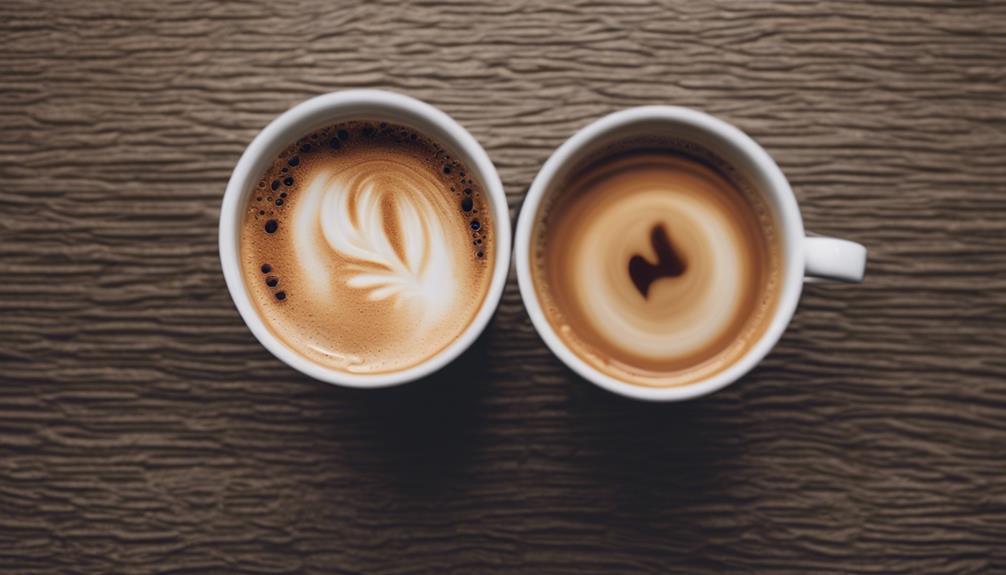
As you explore the world of coffee and espresso, you'll notice a distinct difference in their textures and consistencies.
You'll find that espresso's fine grind and high-pressure brewing method result in a rich, velvety mouthfeel and a thick crema layer on top.
Now, let's break down the key factors that contribute to these unique textures, including the importance of fine grind, the formation of thick crema, and the resulting rich flavor profile.
Fine Grind Importance
When brewing espresso, you'll need a grind size that's finely tuned to guarantee ideal water flow and extraction, since the wrong texture can make all the difference in the flavor and aroma of your shot.
Unlike brew coffee, which uses a medium-coarse grind, espresso requires a finer grind to create the necessary resistance for optimal water flow during brewing. This fine grind coffee allows for a larger surface area, facilitating quick extraction under high pressure and resulting in a concentrated shot with rich flavors and aromas.
The extraction time for espresso is considerably shorter, typically 20-30 seconds, compared to coffee's 4-5 minutes, making the grind size critical for achieving the desired strength and flavor profile.
If the coffee is too coarse, it may lead to under-extraction, resulting in a sour taste, while too fine a grind can cause over-extraction, leading to bitterness.
Thick Crema Formation
You'll notice that the perfect espresso shot is crowned with a rich, velvety crema, which is more than just a visually appealing topping – it's a demonstration of the quality of the brew itself. This thick crema is formed during the high-pressure brewing process, where hot water is forced through finely-ground coffee, creating a layer of microfoam on top.
Here are three key things to know about crema:
- Crema indicates a well-extracted espresso shot, as it signifies the emulsification of oils and gases from the coffee grounds.
- Crema contributes to the espresso's flavor and aroma, enhancing the drinking experience with its rich, golden-brown color.
- Crema provides a smoother mouthfeel, thanks to the tiny bubbles that trap carbon dioxide released during the brewing process.
In contrast, brewed coffee lacks crema because it's made using gravity rather than pressure, resulting in a lighter texture and less concentrated flavor.
The presence of crema is a key difference between espresso and coffee, and it's a major reason why espresso lovers can't get enough of that rich, velvety goodness.
Rich Flavor Profile
The rich flavor profile of espresso is largely attributed to its thicker consistency, which arises from a higher coffee-to-water ratio that allows for a more concentrated extraction of flavors and oils. This is in stark contrast to brewing coffee, where the ratio is much lower, resulting in a lighter texture and less intense flavor.
When you drink espresso, you'll notice the bold and rich flavors that explode in your mouth, thanks to the high-pressure brewing process that forces the water through finely ground coffee beans. This process also creates a rich crema on top, which enhances the overall mouthfeel and taste.
In contrast, coffee brewed using a gravity method yields a lighter texture with a lower concentration of coffee material, resulting in a more subtle and complex flavor profile.
The caffeine content in espresso is also higher due to the concentrated extraction, which contributes to its distinctive kick. Overall, the rich flavor profile of espresso versus coffee is a key difference that sets these two beverages apart.
Caffeine Content Breakdown
One key aspect of coffee and espresso that sets them apart is their drastically different caffeine content per serving. You might be wondering, what's the deal with the difference? Let's break it down.
When it comes to caffeine per ounce, espresso beans pack a punch. A single shot of espresso (1 oz) contains approximately 63 mg of caffeine, making it one of the most concentrated forms of coffee. In contrast, brewed coffee typically contains about 12 mg of caffeine per ounce, leading to a lower concentration compared to espresso.
Here are some key takeaways:
- A single shot of espresso (1 oz) contains around 63 mg of caffeine.
- An 8 oz cup of brewed coffee generally contains around 95 mg of caffeine.
- A double shot of espresso (2 oz) can yield roughly 120 mg of caffeine.
Ultimately, the difference between coffee and espresso lies in their caffeine content breakdown. While espresso has a higher concentration of caffeine per ounce, larger servings of brewed coffee can lead to higher total caffeine consumption.
Equipment and Tools Needed

When it comes to brewing your favorite coffee drinks, having the right equipment and tools on hand can make all the difference.
For espresso, you'll need a specialized espresso machine that can handle high pressure to extract the coffee quickly. These machines range from manual to fully automatic, offering features like customizable shot dosages and milk frothing.
On the other hand, brewing coffee requires equipment like drip coffee makers, pour-over devices, or French presses, each using different methods like gravity or immersion.
Regardless of whether you're brewing espresso or coffee, a burr grinder is a must-have for achieving a consistent grind size. Espresso requires a fine grind, while coffee generally uses a medium-coarse grind.
For espresso preparation, you'll also need a tamper to pack the coffee grounds into the portafilter and a milk frother or steamer to create creamy textures in drinks like lattes and cappuccinos.
Home Brewing Experience Insights
With the right equipment and tools in hand, you'll open a world of possibilities, from rich and creamy creations to expertly crafted espresso drinks that elevate your home brewing experience.
As you explore the world of espresso at home, you'll discover different kinds of brewing techniques and recipes that will take your skills to the next level.
Here are some brewing tips to get you started:
- Experiment with dosing and grinding: Understanding the perfect ratio of coffee to water and the ideal grind size will greatly impact the flavor of your espresso.
- Master the art of tamping: Proper tamping guarantees even extraction and prevents channeling, resulting in a more balanced flavor.
- Don't forget about milk frothing: Learn various frothing techniques to craft velvety-smooth lattes and cappuccinos that will impress your friends and family.
Coffee Bean Selection Guide

You're about to reveal the secret to exceptional espresso: selecting the perfect coffee beans. It's not just about grabbing any bag off the shelf; the right beans can elevate your espresso game. Let's break it down.
| Consideration | Tips |
|---|---|
| Bean Type | Arabica for sweeter, complex flavors; Robusta for stronger, more bitter taste |
| Roast Level | Darker roasts for balanced, sweet flavors; lighter roasts for brighter, more intense flavors |
| Grind Size | Finer grinds necessary for espresso, compared to medium-coarse for regular coffee |
| Blends | Espresso-specific blends adjusted for balanced flavor, but any coffee bean can be used |
| Personal Taste | Experiment with origins, roast levels, and blends to find your ideal flavor |
When choosing coffee beans for espresso, remember that personal taste is key. Experiment with different types of espresso beans, roast levels, and blends to find the perfect flavor that complements your espresso experience. Don't be afraid to try new beans and adjust your grind size accordingly. With the right coffee beans, you'll be well on your way to creating exceptional espresso that suits your taste buds.
Mastering Espresso and Coffee
Mastering the art of espresso and coffee brewing requires a deep understanding of the nuances that set these two beloved beverages apart. To truly excel, you need to grasp the differences between coffee and espresso, from the grind of the beans to the brewing time and technique.
Here are three key takeaways to help you master both:
- Get the grind right: Espresso requires a fine grind, while coffee needs a coarser grind. This affects the water-to-coffee ratio and brewing time, which in turn impact the flavor profile.
- Understand the brewing process: Espresso is brewed using high pressure and a 1:2 water-to-coffee ratio, resulting in a rich, concentrated shot. Coffee, on the other hand, relies on gravity and a 1:18 ratio, yielding a less concentrated beverage.
- Experiment with roast levels: Darker roasts can produce a sweeter, balanced flavor in espresso, while lighter roasts may lead to more intense, bright flavors.
Frequently Asked Questions
How Is Espresso Different From Coffee?
You're wondering how espresso differs from coffee? Well, you'll notice espresso's richer flavor, thicker consistency, and higher caffeine content due to its unique brewing process, which involves high pressure and a finer grind, setting it apart from regular coffee.
Is It Better to Drink Espresso or Coffee?
You're wondering if it's better to drink espresso or coffee? Well, it depends on you! If you crave a bold, rich flavor and a quick energy boost, espresso might be your thing.
Is Espresso Much Stronger Than Coffee?
You might think espresso is much stronger than coffee, but surprisingly, a typical 8 oz. cup of brewed coffee has more caffeine than a single shot of espresso!
What Tastes Better, Espresso or Coffee?
You're wondering what tastes better, espresso or coffee? Honestly, it's up to you – do you prefer a bold, rich flavor or a lighter, more nuanced taste? Your taste buds will decide!
Conclusion
You've made it to the end of this coffee-filled journey, and surprisingly, you still can't tell the difference between coffee and espresso.
Just kidding! By now, you're a pro, and the nuances between these two beloved brews are as clear as a perfectly pulled shot.
But let's be real, it's not about the differences – it's about the ritual, the flavor, and the caffeine high.
So, go ahead, grab a cup, and savor the bean-filled bliss.
